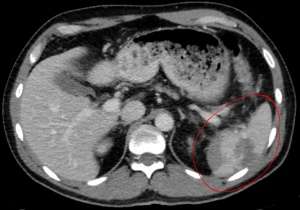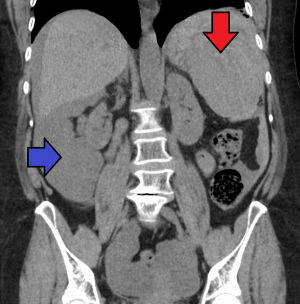Splenic injury
Background
- Most commonly injured visceral organ in blunt trauma
Clinical Features
- LUQ pain
- Signs of shock
- Hypotension
- Left lower rib pain
- Kehr's sign
- Acute pain in the tip of the shoulder due to the presence of blood in the peritoneal cavity when a patient's legs are elevated while laying flat.
Differential Diagnosis
Evaluation

Traumatic rupture of the spleen on contrast enhanced axial CT (portal venous phase).

Splenic hematoma (red arrow) resulting in free abdominal blood (blue arrow).
ATLS Blunt Abdominal Trauma Algorithm
- Unstable
- FAST to search for free fluid (vs. DPL if unavailable)
- Positive: Exploratory laparotomy
- Negative: CT scan
- FAST to search for free fluid (vs. DPL if unavailable)
- Stable
- CT scan
- Exploratory laparotomy, angiographic embolization, conservative management as indicated
- CT scan
AAST Criteria
| Grade | Hematoma | Laceration |
| I |
|
|
| II |
|
|
| III |
|
|
| IV |
|
|
| V |
|
|
Management
- Observation, angiographic embolization, or surgery depending upon:
- Hemodynamic status of the patient
- Grade of splenic injury
- Presence of other injuries and medical comorbidities
- Operative Management
- Indicated for diffuse peritonitis or hemodynamic instability after blunt abdominal trauma
- Not indicated based on injury grade alone[1]
- Nonoperative management
- Failure rate of 10-15%
- Some advocate nonoperative management only if <55yr and CT injury grade less than IV
- Should only be considered in locations with resources available for urgent laparotomy
Disposition
- Admit
See Also
- Abdominal Trauma
- Splenic Infarction
References
- Stassen N, Bhullar I, Cheng J, et al. Selective nonoperative management of blunt splenic injury: An Eastern Association for the Surgery of Trauma practice management guideline. J Trauma Acute Care Surg 2012; 73(5):s293-s300
This article is issued from
Wikem.
The text is licensed under Creative
Commons - Attribution - Sharealike.
Additional terms may apply for the media files.